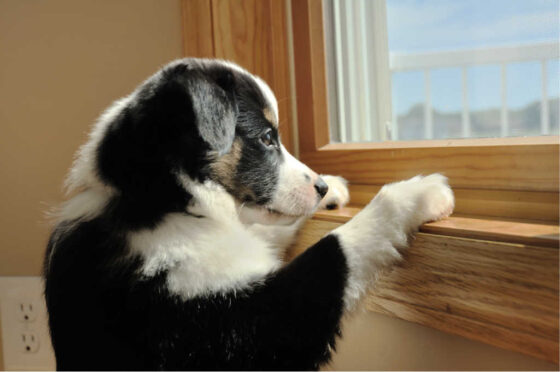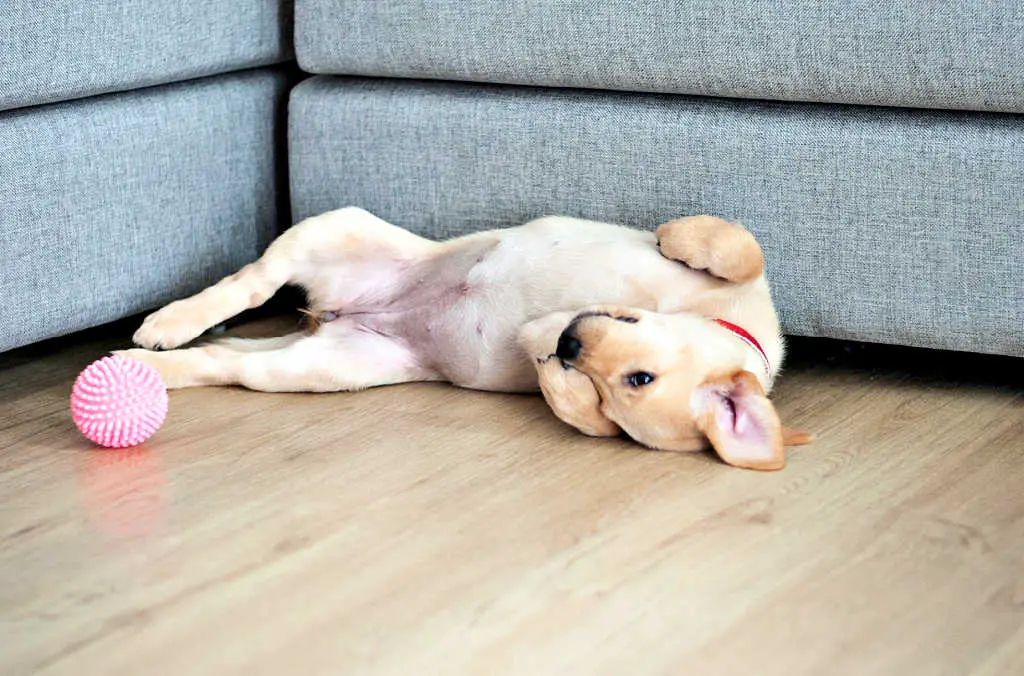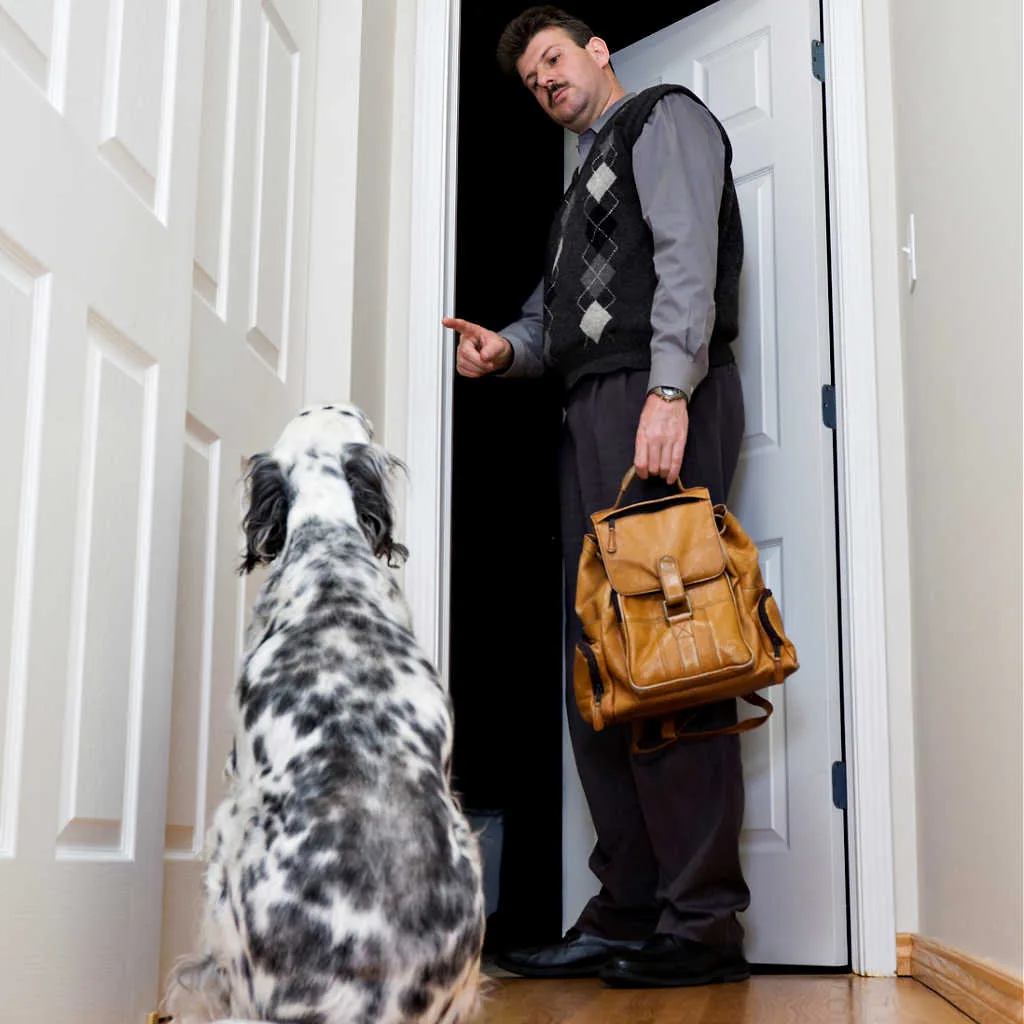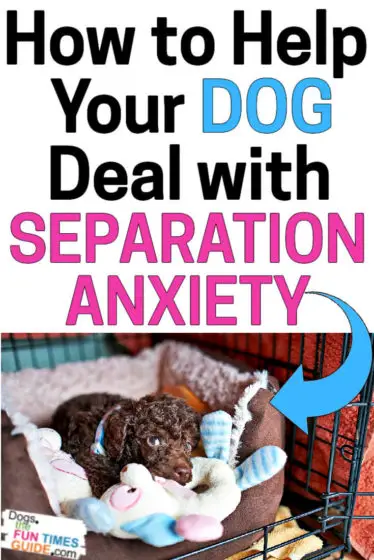Wondering how to help a dog with separation anxiety?…
As adorable as it usually seems on viral videos, crazy behavioral outbursts in dogs can sometimes be a sign of serious emotional problems — such as separation anxiety.
Since its underlying cause is in the dog-owner relationship, there are some practical ways that we can help our furry friends properly deal with detachment and solitude.
Here’s how to nip separation anxiety in the bud — and what you can do to lessen your dog’s symptoms before heading to the vet!
What Exactly Is Separation Anxiety In Dogs?
Separation anxiety is a chronic condition that occurs in dogs who have a tough time parting with their human parents.
It evokes strong emotions — such as:
- agitation
- fear
- restlessness
- and sometimes aggression
Separation anxiety in dogs usually occurs when the dog is dealing with a traumatic experience of some kind.
Common Symptoms
While it depends on the dog’s temper and the severity of the problem, these are the most common symptoms of separation anxiety in dogs:
- Digging and scratching at doors or windows attempting to escape or find the owner
- Destructive chewing, scratching, and digging
- Howling, barking, and whining
- Unusual urination and defecation (even with house-trained dogs)
- Nervous and obsessive pacing
- Excessive panting, drooling, or salivating
- Aggressive growling
- Intense outbursts of energy, zoomies, or going berserk when the owner comes home
Some of these symptoms may be a sign of a different problem — which is why the best idea is to consult with a veterinarian who can help you establish if there was a triggering occasion in the past when your dog could have developed an issue with separation.
What Triggers A Dog’s Separation Anxiety?
When handling your dog’s mischiefs, it’s important to remember that your pooch is not trying to irritate you. His reactions are just a panic response to the emotional state he’s coping with.
In essence, the separation anxiety is triggered by a traumatic event or a situation in which the dog is abruptly confronted with an extremely stressful parting.
Try to recall the time your dog first started to show symptoms and focus on events like:
- Being left alone for the first time
- Being left alone after getting too accustomed to their owner’s presence (if you work from home, for example)
- Going through a traumatic event such as time at a shelter, boarding kennel, abuse, or neglect
- Change in the family’s routine or structure
- Loss of a family member or other pet
- The introduction of another dog (or another pet) in the household
- Change of residence
- Change of the dog’s ownership or primary caretaker
4 Ways To Help A Dog With Separation Anxiety
Most importantly, do not coddle or hug your dog in an attempt to comfort him or soothe his fears. That actually reinforces the behavior — because your dog learns that he will get a hug if he acts scared or nervous. So, as hard as it might be… just don’t do it.
#1 – Try counterconditioning.
For dogs who suffer from separation anxiety, counterconditioning can be an efficient way to “trick” the dog’s mind into eventually accepting occasional alone time.
It’s done by making pleasant and appealing conditions in fearful and threatening situations that would typically induce undesirable behavior.
So try associating your departure (or their alone time at home) with desirable things — like treats, games, delicious food, etc.
For example, when you leave for work, you could leave the dog with:
- a few treat dispensing toys
- a snuffle mat
- some motion-activated dog toys
- dog toys that “talk” or make sounds
- an automatic feeder / food dispenser
- or make a home version of a treasure hunt — where you hide some delicious treats, and let your dog find them
Your dog will come to enjoy these new ways to stay busy while being alone!
#2 – Don’t make a lot of fuss about your comings and goings.
If you’re used to giving your dog lots of hugs and kisses before going out… DON’T.
And if you normally hug your dog and talk in a high-pitched voice the moment you walk in the door… DON’T.
Dogs with separation anxiety will interpret those types of interactions with their owner as times that something scary is about to happen to them — or recently happened to them. So, you don’t want to emphasize your comings and goings in your dog’s presence.
Instead, try to:
- Keep your greetings low-key and actually ignore your dog the first few minutes upon your arrival. Even if your dog is excited to see you (and you’re excited to see him), it’s best to remain calm as if nothing special has happened. You want to show as little excitement toward your dog as possible each time that you return home.
- Make your leaving less traumatic each time. One way is to leave a clothing item, your bed pillow, or something else familiar to your dog with your scent on it out in the open. It will make your dog feel that you are nearby, and it will comfort him while you’re away. As you’re walking out the door, just give your dog a treat and leave calmly.
#3 – Help your dog exert a lot of energy before you leave him alone.
The more your dog burns off energy, the more tired he will be — thus, he will have less energy for being fearful, crying, or being destructive when left alone.
The best way to burn off energy is to physically play with your dog:
- Play catch, frisbee, or “tag” in the yard with your dog
- Take your dog for a car ride
- Go on a walk or jog with your dog
- Take your dog to an off-leash dog park
- Go on a hike or fun outing with your dog
You could also take your dog to doggie daycare — where dogs play with one another, while being supervised by adults.
#4 – Turn your dog’s living space into a calming resort.
By creating a cozy nook for your dog, it may help him feel more comfortable and safe when left alone.
Choose a separate area or a spare room that you can equip with:
- a cozy bed
- interactive dog toys
- comfy dog accessories
- a spacious crate
- other items that your dog loves
Dogs are territorial, so crate training could be a perfect solution for giving your dog a private and isolated area to go to when scared, upset, or agitated.
TIP: Crating your dog when you leave home can sometimes have an opposite effect by amplifying your dog’s fear and stress. If this is the situation with your dog, you can still use a crate — just keep the crate open and unlocked!
Things You Should NOT Do For A Dog With Separation Anxiety
Remember that your dog’s behavior isn’t a consequence of improper training — it’s due to an earlier traumatic event in your dog’s life. So, severe punishments and strict obedience training will just make things worse.
Avoid anything that could disturb peace and safety, such as:
- Making loud noises
- Locking your dog up in small places
- Leaving your dog in a dark room
The Bottom Line
Keep in mind that your beloved four-legged companion is definitely having a harder time than you are — so treat your dog like you would yourself when you are anxious and scared.
Sometimes the best solution is to leave things to the professionals — especially if severe separation anxiety is the problem. So don’t be hesitant about consulting a veterinarian.
In certain cases, the things that could help your dog best are mild natural remedies or medication for calming the nerves. Those could at least start your dog down the path to recovery.
Dog trainer Zak George has some more excellent tips in this video:
RELATED: How To Help A Dog Who’s Nervous & Scared Around Strangers
Lauretta Williams is a co-founder at PawMaw.com, a website dedicated to reuniting people with their lost pets. In her free time, she enjoys sharing helpful tips for caring for dogs.
Like this post? Save it to read again later… or share with others on Pinterest!
I like to help Dog Parents find unique ways to do things that will save time & money — so I write about “outside the box” Dog Tips and Dog Hacks that most wouldn’t think of. I’m a lifelong dog owner — currently have 2 mixed breed Golden Aussies that we found abandoned on the side of the road as puppies. I’ve always trained my own dogs and help friends train theirs, as well. Professionally, I worked at a vet and have several friends who are veterinarians — whom I consult with regularly. (And just because I love animals so much, I also worked at a Zoo for awhile!) I’ve been sharing my best ideas with others by blogging full-time since 1998 (the same year that Google started… and before the days of Facebook and YouTube). My daily motivation is to help first-time dog owners be better prepared from the first day your new puppy enters your home. I like to help dog owners understand what’s ‘normal’ and what you can expect in terms of living with and training your dog — how to get through the ups & downs of potty training, chewing, teaching commands, getting your dog to listen, and everything else that takes place during that hectic first year! When I’m not training, walking, grooming, or making homemade treats for my dogs, you will find me at the corner of Good News & Fun Times as publisher of The Fun Times Guide (32 fun & helpful websites). To date, I’ve written over 600 articles for dog owners on this site! Many of them have upwards of 200K shares.











